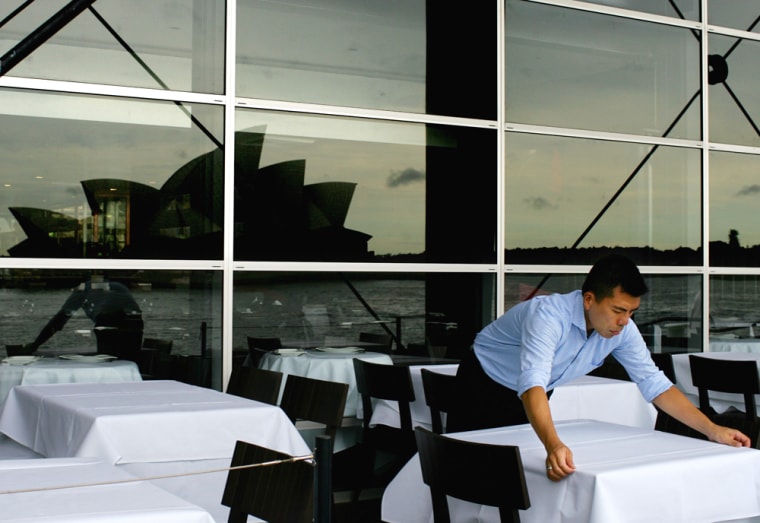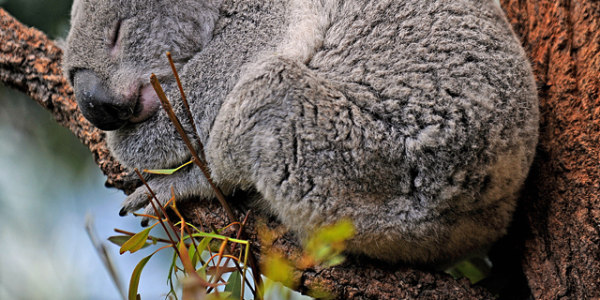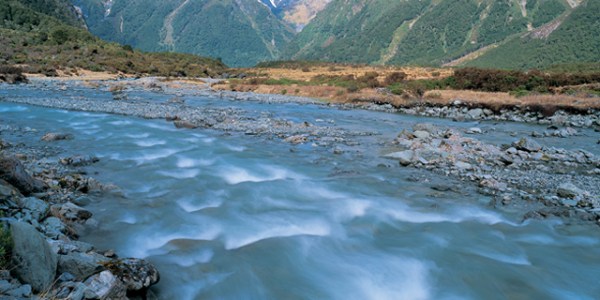Australia and New Zealand, Aussies and Kiwis: peas in a pod? Clones? Two parts of the same country? Given the fact that in cruise parlance the two are seldom uttered separately, it's hard not to make these assumptions. After all, folks from both places talk in the same funny, almost-Brit-but-not-really accents, drive on the wrong side of the road and, like everyone else below the equator, walk with their feet up and their heads down.
But these are myths. In fact, Australia and New Zealand are about as different as two neighboring countries can be. Starting with geography, Australia is one of the flattest land masses on the planet, its highest point rising 7,310 feet above sea level. New Zealand is extremely mountainous, with Mount Cook towering over 12,000 feet. Australia's land features are best characterized as gentle and regular, with sloping plains and, with the exception of Sydney Harbour, a smooth coastline with few inlets or bays.
In contrast, New Zealand's shoreline, like Norway's, is deeply incised with steep fjords, and in contrast with its neighbor's flat plains and deserts, its terrain tends to be rugged and precipitous, punctuated by permanent glaciers and white water rivers. New Zealand's wintry alpine heights call Alaska to mind. Australia's Great Barrier Reef, its most famous natural treasure, is built from the same Pacific hard corals as the reefs surrounding the islands of Hawaii.
In terms of wildlife, there couldn't be more difference. Australia is home to hundreds of species that exist nowhere else in the world. Some, like the duck-billed platypus, are so bizarre that initial descriptions from explorers were dismissed as delusions or fabrications. Conversely, New Zealand has a tiny handful of indigenous species, including only one class of mammals (bats) and a short list of reptiles and birds, including the flightless kiwi, which lends its name to New Zealand's human denizens.
Speaking of humans, New Zealand is far more densely populated -- 37 per square mile vs. seven for Australia -- so it may come as a surprise that, of the two, Australia is far more urban. The population of the city of Sydney, Australia, is greater than the entire population of the country of New Zealand. Both countries have substantial commitments to farming and ranching, with sheep being the major cash crop -- though when it comes to lamb, the Kiwis tend to sear 'em while the Aussies are likely to shear 'em, which is why you've never heard, "Throw another lamb on the barbie!"
And, regarding the people, Australia and New Zealand have grown from different seeds and blossomed differently as well. Australia's earliest European settlement was a penal colony founded by the British in Botany Bay, so convicts formed the first wave of immigrants. In 1851 gold was discovered, stimulating a gold rush. The third group to sweep into the country was sheep ranchers. Given a country settled by convicts, ranchers, gold and opal prospectors, and miners, it's not difficult to see the roots of the Aussies' rough-and-tumble, fiercely independent, wild and woolly spirit; it's a version of our own wild west frontier.
By contrast, New Zealand began its independent life in 1852 as a regulated welfare state, and remained so until 1984 when it moved more into a market economy. The country's development has largely caught up with Australia's, though both economies remain primarily agrarian and service-based, with only 15 percent of the GDP generated by manufacturing.
Okay ... so now I know enough to win the Australia/New Zealand category on "Jeopardy!". What does this have to do with my cruise?
A lot. Being familiar with the depth of the difference between the two countries will factor into your decisions on wardrobe, packing, choice of when to cruise, interaction with the locals and what activities best suit what ports of call (See "What to Do Ashore" below).
Who Goes?
It's worth noting that Australia/New Zealand, which has long been considered an "exotic" destination for North American travelers -- one which tended to draw older vessels on super-long itineraries that were usually out of range (price- and length-wise) for most of us -- is getting some serious new action.
For instance, Princess has really committed to a presence here in the Southern Hemisphere's summer -- assigning for the past two years its newest, splashiest and biggest ships -- such as Sapphire and Diamond Princess. Holland America dipped a proverbial toe in the water, sending over the mid-sized Statendam for the 2005/2006 season; it was so successful that early on the line announced the ship would return next year and hinted that, in 2008, it would assign one of its Vista-class ships. These, for HAL, fall into the category of the fleet's biggest and splashiest.
The luxury lines are all well represented here, including Silversea and Seabourn. Expedition-wise, folks who want eco-adventure should check out a new small-ship line. Based in Australia, Orion Expedition Cruises' Orion, custom designed and built in 2003, sails really interesting and offbeat itineraries. The 4,000-ton, 106-passenger ship calls at small ports in Australia as well as ports in East Timor, Papua New Guinea and Antarctica.
Another option is to cruise via P&O Australia. Part of the Princess family of cruise lines, this Australia-based line mostly markets to a "down under" crowd and -- we'll say it outright -- cruising on this line reflects the differences in travel personalities between Aussies and Americans (it's much more casual, with less emphasis on service and lower prices).
Don't Forget This!
Australia requires that all U.S. and Canadian visitors acquire visas. The good news? It's really easy because they've set up an electronic system and it only costs $35 (good for 12 months); no photo is needed. Your cruise line will advise you -- or go straight to Zierer Visa.
The Australia/New Zealand Cruise Season
Both countries claim temperate or sub-tropical climates, with the seasons reversed from the pattern in the Northern Hemisphere. So, winter in North America is summer there. Australia's position closer to the equator puts it at the outer edge of typhoons, the Southern Hemisphere's equivalent of our hurricanes. Typhoon season runs from December 1 - May 30, affecting ports of call such as Brisbane and Cairns more than Sydney (but note: waters there and on New Zealand's west coast were somewhat rough during our January voyage). New Zealand, lying south of the cyclone belt, is not as affected, but the warning above still applies.
Summer temperatures differ by about 10 degrees, with Australia's high-temp averages in the low to mid 80s. Statistically it would seem that both countries experience the same rainfall patterns, with rainy-region annual totals in the 100-inch range and dry-region totals about half that; however, meteorologists characterize New Zealand as the greener and rainier climate, which visitors empirically confirm.
A Few Hints About Itineraries
Three classes of conventional ships sail Australia/New Zealand itineraries.
The mid-price niche is dominated by Princess and Holland America, which run the itinerary annually each winter. For the most part, itineraries pretty much stick to "greatest hits" ports of call on the Auckland - Sydney run, with stops in cities such as Melbourne, Dunedin and Christchurch along with a visit to Tasmania. P&O Australia, which operates three ships in the region, gears most of its marketing efforts to travelers in the Far East and in Australia and New Zealand (but offers a wonderfully "local" experience for North Americans). Other cruise lines that offer summer cruises there include U.K.-based P&O and Cunard. Clipper Cruise Line and the aforementioned Orion Expeditions represent the second group, the small-ship/expedition niche.
By far the greatest range of choices is offered by the ships in the third class: the upscale, pricey ships of Seabourn, Regent Seven Seas and Silversea. They typically stop in smaller, more unusual ports of call than the bigger, mass-market vessels.
An Interesting Twist
You'd think that a trip to the Great Barrier Reef would be one of those "greatest hits" stops, but it's not -- so if this major natural wonder is an important part of your Australia experience, you need to check itineraries carefully. Typically, only luxury and expedition lines call at ports in the general vicinity.
Slideshow 9 photos
Explore New Zealand
Those who would never consider a trip to Australia without seeing the Great Barrier Reef should consider itineraries on ships that sail between Australia and Asia instead of New Zealand. Many of these sailings offer access to the Reef through port calls at Cairns, Brisbane or the Whitsunday Islands. The eco-oriented lines are another good choice; Orion, for instance, offers Cairns-based voyages.
Lastly, no matter the line on which you sail, consider extending your trip to visit places not covered by the itinerary. All the lines offer some sort of pre- or post-cruise experience (for instance, Holland America offered Statendam passengers a chance to see Cairns and the Great Barrier Reef). Frankly, it's easy enough to get around both countries on your own too, and both are worth more in-depth travel.
For some unusual options for seeing the Reef, see "Experiencing Queensland," below.
What to Do Ashore
In general, recommendations for the best shore experiences mirror the contrasting characteristics of the two island nations: Australia is the best choice for urban life and animal encounters, while those loving natural experiences of the scenic, white-water and glacial kind will have their best chance at them in New Zealand. In a port-by-port analysis based on some popular ports, here's a list of the best choices ashore:
Sydney, Australia
From the Circular Quay (where the ship docks), all of Sydney is open to you. This is also the terminus or access point for at least six different forms of transportation: bus, taxi, ferry, water taxi, hydrofoil and rail. All that and you can walk to enough sights to fill a week, much less a port call. Besides the Sydney Opera House and the Harbour Bridge (if you wish to climb it, bypass that Bloody Mary; they require a breathalyzer test before letting you make the trek), take a stroll over to The Rocks. This used to be the hardy seamen's hangout but is now your destination for the typical Aussie pub experience, rubbing elbows with your typical freewheeling locals without getting too far from trendy T-shirt, jewelry and souvenir shops.
Maximize your exposure to the wide range of unusual Aussie wildlife cuddling kangaroos and koalas at the Taronga Zoo, or any of the open wild animal preserves that proliferate in Sydney's environs.
Melbourne, Australia
A fabulous thriving city, Melbourne, founded in the mid-19th century, reflects both a Western heritage (primarily in its Victorian architecture) and an Eastern sensibility (the city is rife with lush gardens and parks). Melbourne, which is actually the country's business center, is currently in the midst of a redevelopment boom which is vastly improving the city. Plus, it's got lots of great ethnic neighborhoods to explore. It's a fabulous blend of old and traditional and new and hip.
Hobart, Tasmania, Australia
Australia's second oldest city (after Sydney) offers a glimpse into the country's past of penal colonies and rough-and-tumble seaports.
Burnie, Tasmania, Australia
While Burnie is a sweet town -- and a great place to pick up essentials, from books to wine -- its real appeal as a cruise port is the pastoral countryside around it, where you'll find everything from underground caves to a fabulous farm for animals rescued from the wild.
Dunedin, New Zealand
This is the closest you'll get to Scotland in the Pacific. If you can't possibly return from the South Pacific without buying a kilt or a locally fermented single malt whisky, you've come to the right place. Shore excursions will take you close enough to Antarctica to visit with penguins or far enough inland to explore one of New Zealand's precipitous gorges.
Christchurch, New Zealand
No city in New Zealand better exemplifies its British roots than here in Christchurch, which will definitely remind you of a small English city -- Oxford, perhaps -- in a small way. There are lovely botanical gardens, a vibrant downtown and a wonderful arts corridor (that conveniently links the city center with the gardens). And its relative proximity to the Antarctic has made it a hub for museums that focus on that vast icy wonderland.
Wellington, New Zealand
Wellington, New Zealand's cosmopolitan capital city, is located at the southern tip of the North Island and at the physical center of the country. The city is nestled between the harbor and steep, forest-clad hills -- and is wonderfully walkable. The revamped waterfront area leads from the cruise dock at the eastern edge of town to the must-see Te Papa museum in the west. A stroll along the quay is filled with surprises. There's a grassy playground for kids, large-scale sculptures and fun wooden walkways. Cross the street, and you'll have your choice of cafes and shops.Auckland, New Zealand
Your jumping-off point for immersing yourself in Maori culture, going sailing, or visiting nearby caves and geysers, Auckland is also a great spot from which to explore its outlying islands (especially Waiheke), gorgeous craggy Pacific coast, charming small towns (Devonport), or urban neighborhoods (Parnell and Ponsonby). And don't miss the vistas from the iconic Sky Tower (you can even bungee jump off the thing).
Bay of Islands, New Zealand
If experiencing New Zealand's natural treasures, forests and water-intensive activities is important to you, this may be the highlight of your entire cruise. This is prime sailing territory, so look for the chance to participate in guided sailing excursions. If your ship offers charter fishing trips, and you're so inclined, this is (according to Zane Grey) one of the top deep-sea fishing locations on the planet. Forest and shoreline hiking will expose you both to evidence of the first Maori communities encountered by Europeans and to what was once the booming, swashbuckling whaling and maritime center of life in New Zealand.
Experiencing Queensland
In addition to combining your cruise with a land tour, there are other ways to explore Queensland and the Great Barrier Reef, if that aspect of Australia is tops on your must-do list:
 Go with a local small-vessel line like Captain Cook Cruises. They do three-, four- and seven-night cruises to the Great Barrier Reef from Cairns. Also worth a look is Kangaroo Explorer Cruises. Their Web site s temporarily closed, but a Google search will lead you to a number of Aussie travel operators whose sites do contain detailed information. Kangaroo Explorer is a 40-passenger luxury catamaran motor yacht that sails four- and seven-night Reef itineraries out of Cairns.
Go with a local small-vessel line like Captain Cook Cruises. They do three-, four- and seven-night cruises to the Great Barrier Reef from Cairns. Also worth a look is Kangaroo Explorer Cruises. Their Web site s temporarily closed, but a Google search will lead you to a number of Aussie travel operators whose sites do contain detailed information. Kangaroo Explorer is a 40-passenger luxury catamaran motor yacht that sails four- and seven-night Reef itineraries out of Cairns.
 Consider a crewed yacht charter, which is less expensive than you might think; three couples sharing a one-week sailing on a yacht with a skipper and cook/mate can sail for as little as $1,000 to $2,000 per person. The two big players in the region are The Moorings and Sunsail. Both companies are located at Hamilton Island, and sail the Whitsunday Islands, arguably the Great Barrier Reef's most beautiful and pristine area.
Consider a crewed yacht charter, which is less expensive than you might think; three couples sharing a one-week sailing on a yacht with a skipper and cook/mate can sail for as little as $1,000 to $2,000 per person. The two big players in the region are The Moorings and Sunsail. Both companies are located at Hamilton Island, and sail the Whitsunday Islands, arguably the Great Barrier Reef's most beautiful and pristine area.
, which launched in 1995, is a comprehensive cruise vacation planning guide providing objective cruise ship reviews, cruise line profiles, destination content on 125+ worldwide ports, cruise bargains, tips, industry news, and cruise message boards.


